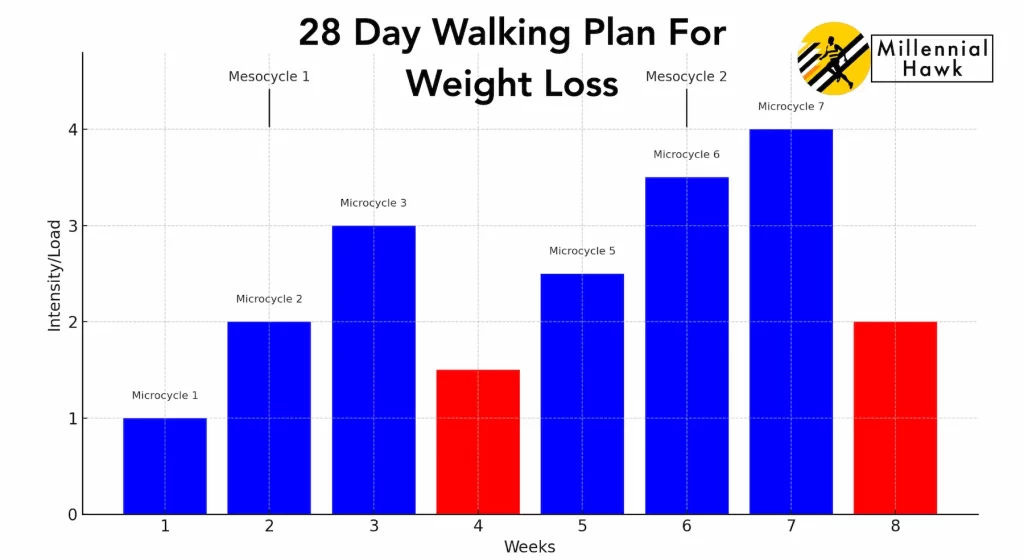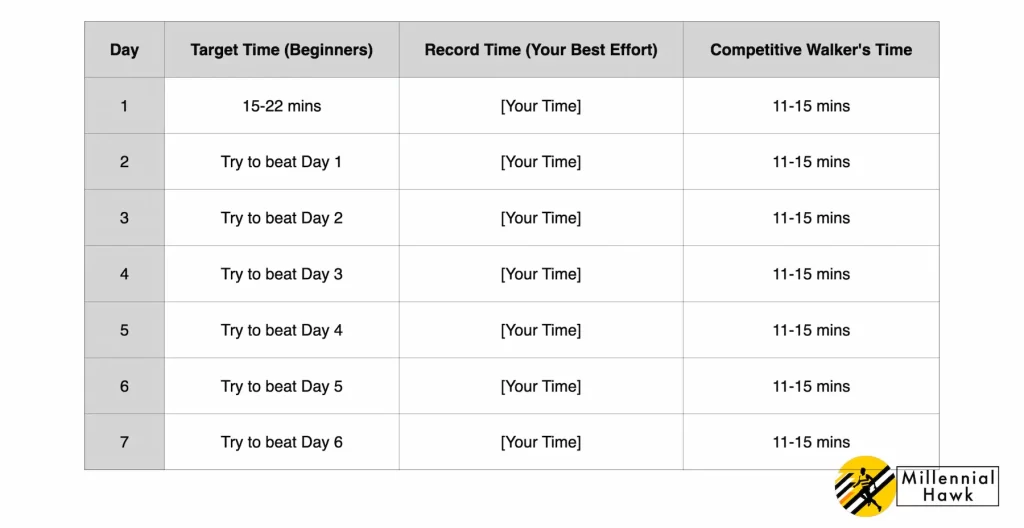A walking routine for weight loss is a free exercise plan tailored for beginners or the untrained, focusing primarily on various walking techniques to elevate calorie burn, enhance cardiorespiratory health, optimize body composition, and boost aerobic capacity. It includes the warm-up, main workout, and cooldown phases, and can encompass various types of exercises depending on the individual’s goals and fitness level.
A well-organized walking plan provides a clear roadmap for individuals, specifying which type of walk to embark on, when to do it, and how to approach it. This clarity removes uncertainty and can substantially boost commitment to the walking regimen.
When asking if a walking workout is effective for weight loss, we can point to the 2017 study by Bernadette Kleist from the University of Applied Sciences in Muenster, which found that a combination of an energy-restricted diet and moderate walking for 2.5 hours per week over 12 weeks resulted in more pronounced reductions in total fat mass compared to dieting alone.
The 28-day walking plan for weight loss is a 4-week mesocycle, segmented into four 7-day microcycles, each targeting a distinct objective within a potential larger 12-month macrocycle, ensuring a systematic progression for peak performance and recuperation. It advocates for a cautious approach, recommending no more than a 10% augmentation in frequency, intensity, or duration monthly, as illustrated in this diagram.

This article presents a 4-week walking plan for beginners, with each week (or 7-day microcycle) focusing on a different aspect: endurance, strength, power, and recovery, as detailed in the list below.
- 7-day short-distance walking workout
- 7-day long-distance walking workout
- 7-day power walking workout
- Recovery walking workout
7-Day Short-Distance Walking Workout
A 7-day short-distance walking workout, also known as the “walk a mile workout,” is the introductory week of the 28-day walking exercise plan for weight loss. Specifically designed for beginners, participants complete a 1-mile walk daily over seven days, measuring time and striving to better their record each subsequent day.
Your goal is to measure and record your time daily, to walk faster and more efficiently the following day.
The goal is progressive improvement, aiming for increased speed. When asking how fast one should walk a mile, we can refer to a 2019 study by Line Jee Hartmann Rasmussen from Duke University, which found that the average individual can walk 1 mile (equivalent to 1.6 km) within a range of 15 to 22 minutes when moving at a moderate pace of 3-4 miles per hour.
So your benchmark is to complete the mile in 15 to 22 minutes unless you’re already a competitive walker. Competitive walkers, as highlighted by a 2015 study by Sarah Hanson from The University of East Anglia, can achieve a mile in as fast as 11 minutes. These individuals are typically in peak physical condition and can sustain a brisk pace over the mile. Ideally, a fast mile should be completed in 11 to 15 minutes.
This table shows the 7-day short-distance walking workout plan.

Be sure to monitor your walking distance. After completing the 28-day walking workout plan for weight loss, you’ll return to the “walk a mile challenge,” but with a raised baseline.
7-Day Long-Distance Walking Workout
The 7-day long-distance walking workout is the second week of the 28-day walking workout plan designed for weight loss, emphasizing longer walking distances. Starting with a baseline of 2 miles on the first day, participants typically take between 30 to 40 minutes to complete this distance, though factors like age, gender, fitness level, and terrain can affect this duration.
Specifically, women average between 38 to 47 minutes for 2 miles, while men take about 35 to 43 minutes. Translated to steps, this is approximately 4,200 steps.
This week incorporates various walking styles, such as moderate-paced walking, brisk walking, power walking, and Nordic walking. If feasible, you can also engage in hiking, especially in hilly terrains.
Every day of the week offers a unique challenge, including specialized days for endurance, speed, and extended walking sessions. You are encouraged to explore longer walking routes throughout the week.
The following table shows a 7-day long-distance walking workout.
| Day | Walking Workout | Description |
|---|---|---|
| Day 1 | Warm-Up Walk & Baseline Measurement | A mix of Speed & Endurance |
| Day 2 | Progressive Distance | Begin with a 10-minute warm-up. Walk 2.5 miles aiming to improve on Day 1’s pace. Cool down for 5 minutes. |
| Day 3 | Endurance Day | Warm up for 10 minutes. Walk 3 miles at a moderate, consistent pace. Cool down for 5 minutes. |
| Day 4 | Rest or Active Recovery | Either rest or do a gentle 1-mile walk. |
| Day 5 | Speed Challenge | Start with a 10-minute warm-up. Walk 2 miles faster than on Day 2. Cool down for 5 minutes. |
| Day 6 | Long Walk Day | Warm up for 10 minutes. Take a 4-mile walk focusing on a steady pace. Finish with a cool down and stretch. |
| Day 7 | A mix of speed & Endurance | Begin with a 10-minute warm-up. Walk 1 mile as fast as possible. Continue with a 2-mile moderate-paced walk. Cool down for 5 minutes. |
Make sure you wear appropriate long-distance walking shoes, keep yourself well-hydrated, and consistently monitor your stats.
7-day Power Walking Workout
The 7-day Power Walking Workout is the third week of the 28-Day walking workout plan for weight loss, designed to be the most challenging week with a mix of training techniques.
Power walking is the act of walking briskly, typically at speeds of 7 to 9 km/h (4.5 to 5.5 mph), ensuring at least one foot maintains contact with the ground, distinguishing it from jogging or running.
This form of exercise elevates the heart rate, and for added intensity, you can opt for hilly terrains or stairs.
It’s beneficial to have a workout companion if possible, as power walking has a rich history, technique, competitions, and health benefits associated with it.
While the primary focus is on weight loss and fitness, it’s noteworthy that one can also walk a full marathon, and with proper training, participants can finish within the stipulated time, as many marathons now accommodate walkers.
This table shows a 7-day power walking workout.
| Day | Workout Name | Description |
|---|---|---|
| Day 1 | Introduction to Power Walking | Start with a 10-minute warm-up walk. Power walk for 20 minutes at 7 km/h. Cool down with a 10-minute slow-paced walk. |
| Day 2 | Speed Variations | Begin with a 10-minute warm-up. Alternate between 5 minutes at 8 km/h and 5 minutes at 7 km/h for 30 minutes. Cool down for 10 minutes. |
| Day 3 | Endurance Boost | Warm up for 10 minutes. Power walk for 40 minutes at roughly 7.5 km/h. Cool down for 10 minutes. |
| Day 4 | Active Recovery | Engage in a relaxed 30-minute walk, emphasizing posture and breathing. |
| Day 5 | Challenge Day | Start with a 10-minute warm-up. Aim for a 20-minute power walk at 9 km/h. Cool down for 10 minutes. |
| Day 6 | Marathon Prep | Warm up for 10 minutes. Engage in a 60-minute power walk at 7.5 km/h. Finish with a 15-minute cool down and stretch. |
| Day 7 | Mixed Training | Begin with a 10-minute warm-up. Alternate between 10 minutes at 8 km/h and 5 minutes of casual walking for 45 minutes. Cool down for 10 minutes. |
7-Day Recovery Walking Workout
The 7-day recovery walking workout is the concluding week of a 4-week walking plan tailored for beginners, emphasizing recuperation and rejuvenation. While it incorporates strength training exercises such as squats and lunges, the walking volume is deliberately reduced.
This week is characterized by leisurely activities like beach and dog walking, combined with lighter-intensity exercises. Emphasis is also placed on holistic recovery methods, including stretching, foam rolling, and walking meditation, to ensure overall well-being and readiness for subsequent fitness endeavors.
The following is the 7-day recovery walking workout plan.
- Day 1 (Leisure Stroll): Start your day with a 20-minute leisure walk in a park or around your neighborhood. Follow up with 10 minutes of stretching focusing on the legs and back
- Day 2 (Strength & Light Walk): Begin with 3 sets of 10 squats and lunges. Follow with a 15-minute light-intensity walk. Conclude with 10 minutes of stretching.
- Day 3 (Beach Walk): If accessible, head to the beach for a 30-minute beach walk. The sand adds a different dimension to the walk. Complete the day with foam rolling, especially focusing on the calves and thighs.
- Day 4 (Dog Walking Day): If you have a dog, take them for a longer-than-usual walk, aiming for about 30 minutes. If you don’t own a dog, just enjoy a casual 30-minute walk. End with gentle stretching.
- Day 5 (Walking Meditation): Find a quiet place, either indoors or outdoors. Engage in a 20-minute walking meditation, focusing on your breath and every step you take. Finish with a 5-minute seated meditation.
- Day 6 (Strength & Recovery): Start with 3 sets of 10 squats and lunges. Go for a 20-minute leisure walk. Dedicate 15 minutes to foam rolling and stretching, targeting any areas of tightness or discomfort.
- Day 7 (Nature Walk & Relaxation): Choose a calm and scenic location for a 30-minute nature walk. Follow your walk with 10 minutes of stretching. Conclude with a 10-minute seated meditation or relaxation technique.

